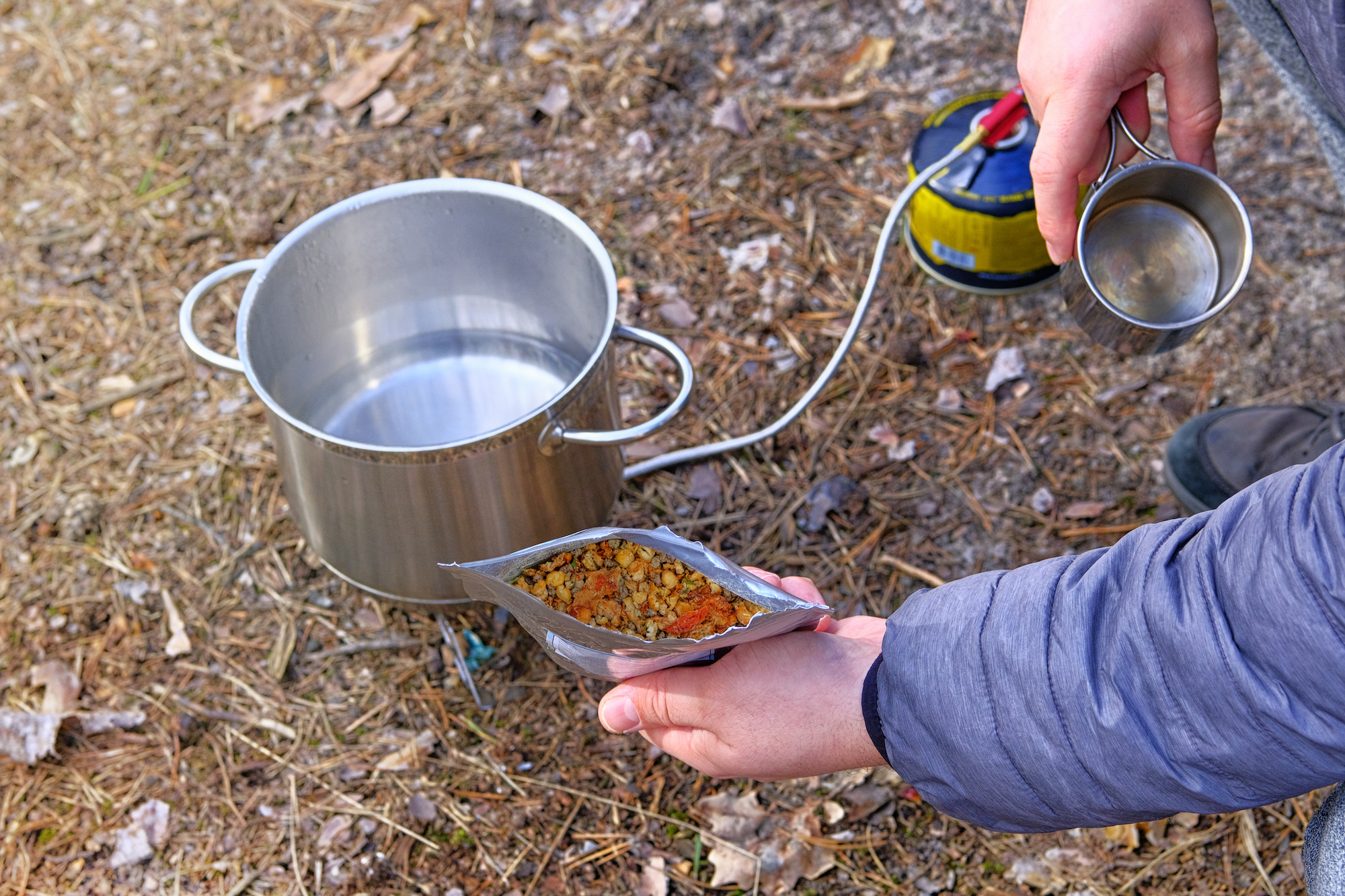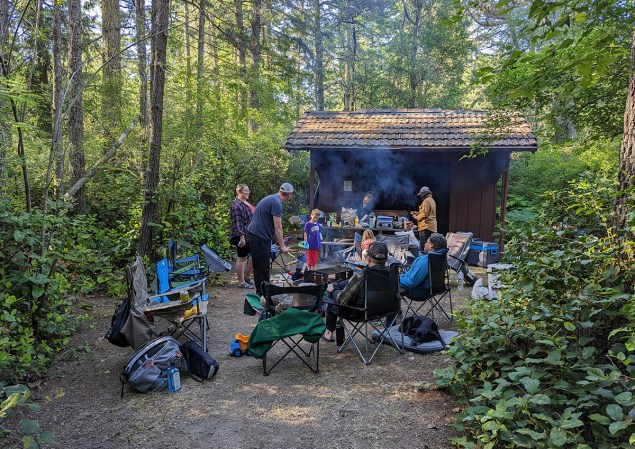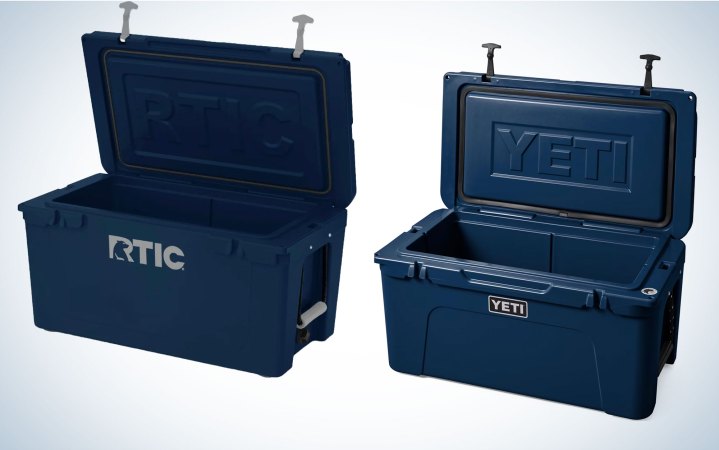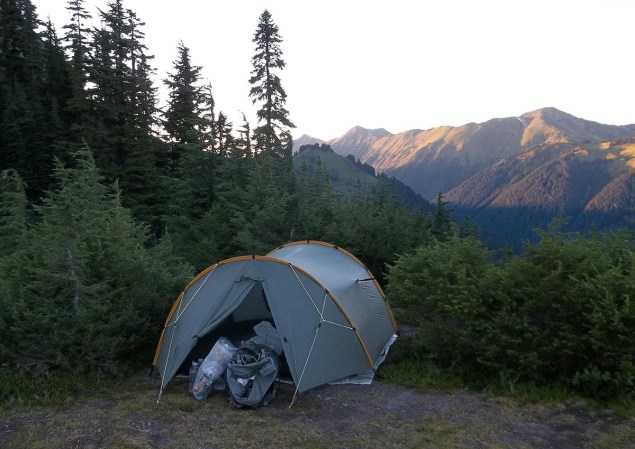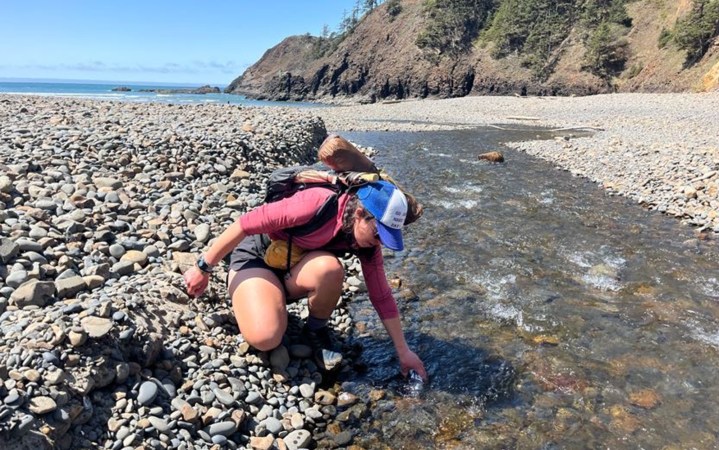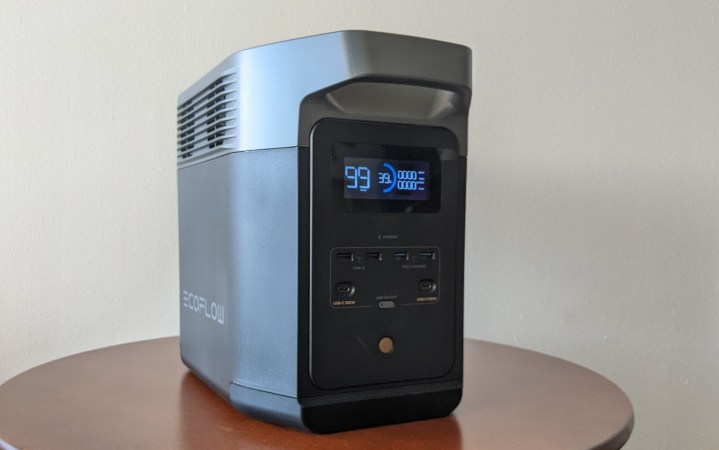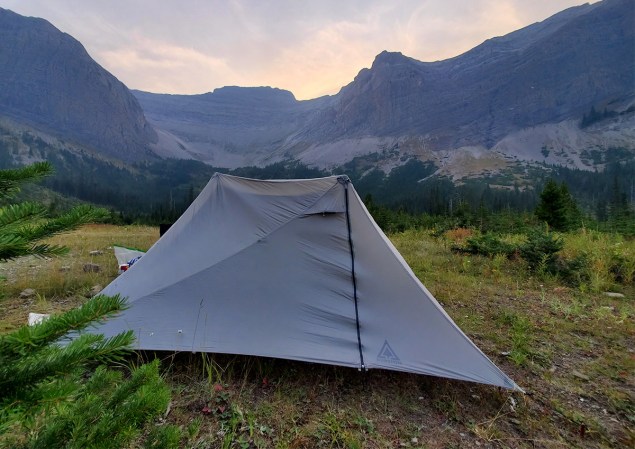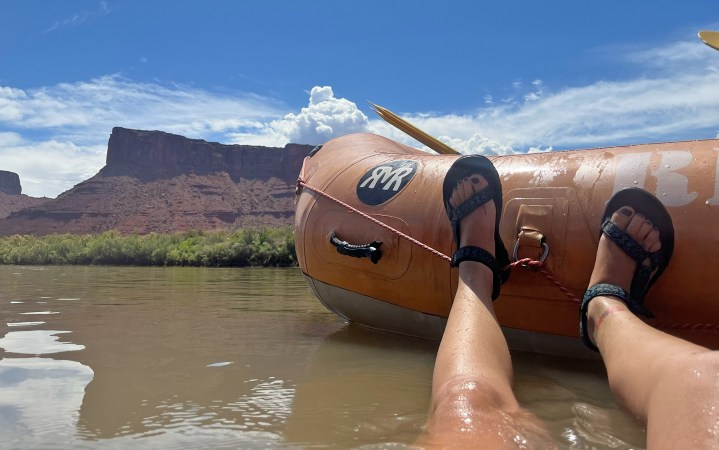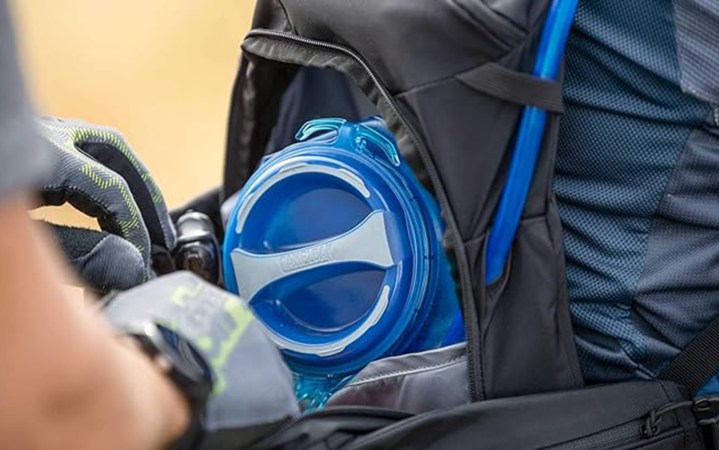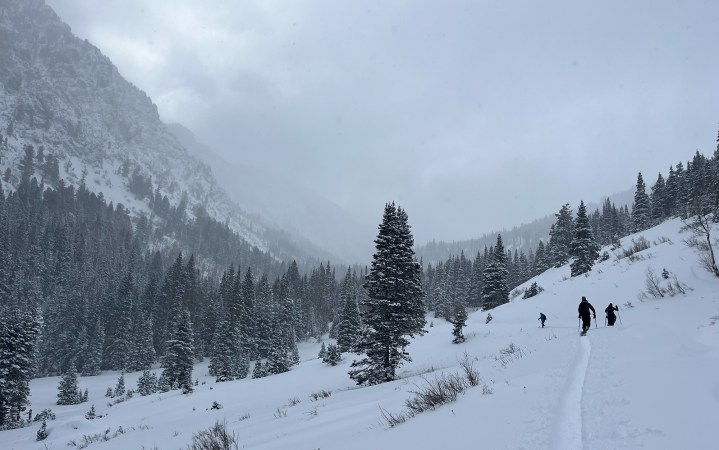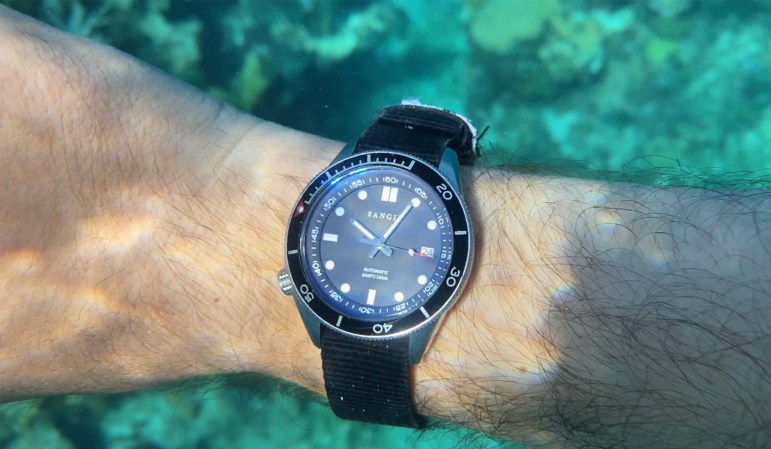We may earn revenue from the products available on this page and participate in affiliate programs. Learn More ›
Dehydrating food has been a practical preservation strategy since ancient times. Today, dehydrated foods pop up everywhere from your favorite snack aisle to your local sporting goods store. Freeze-dried meals are especially popular among the backpacking crowd, thanks to their featherweight proportions and their ease of preparation. Just add hot water and backcountry dinner is served.
But thanks to today’s readily available dehydrators and vacuum sealers, it’s easier than ever to dehydrate your own food and package your own backpacking meals—or jerky, soup mix, or fruit leather. We spoke with master food dehydrator and backpacking meal connoisseur Glenn McAllister, founder of Backpacking Chef and author of multiple backpacking meal recipe books and guides, to get an idea for what the process is like. Here’s how to make your own dehydrated backpacking meals.
Why Make Your Own Backpacking Meals?
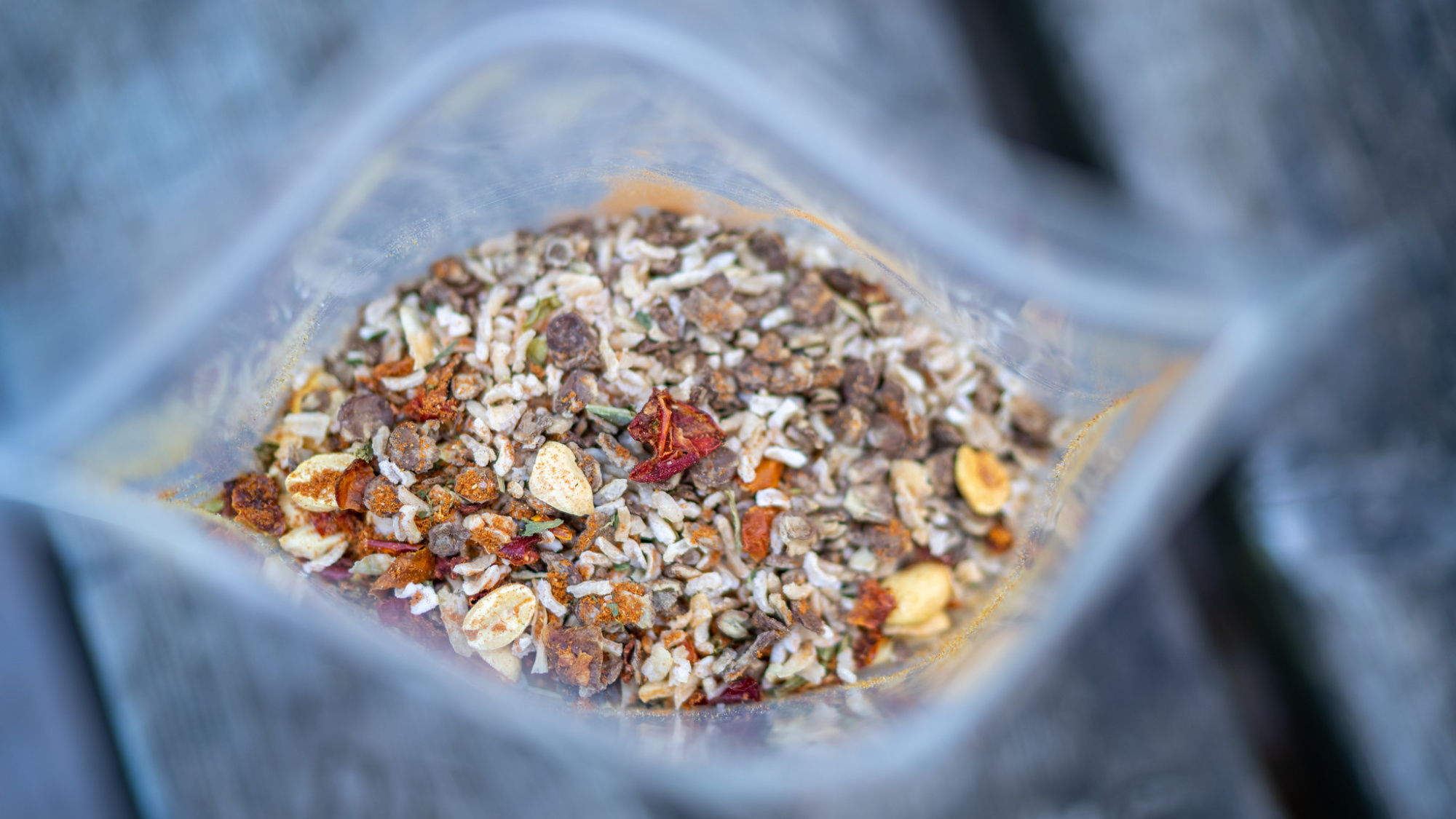
Don’t get us wrong, we have eaten our fair share of dehydrated and freeze-dried meals. (The OL Gear Team even did a huge test of different brands and recipes to determine the best backpacking food and best survival food out there.) But they’re also specifically designed to refuel you after a long, aggressive day of backpacking where you sweat out most of your sodium and need 50 grams of protein from a single meal, which isn’t always the case. Maybe you have dietary restrictions or need to watch your sodium intake. Maybe you hate the way pre-packaged freeze-drieds make you feel. Or, most reasonable of all, maybe the meals for sale at various sporting good stores seem overpriced and unappetizing, and you think you can do it better yourself.
By dehydrating food and making your own backpacking meals, you have complete control over what you eat when your day of adventure is done. This means loading up on the flavors and textures that you know you’ll crave, and avoiding ingredients that you know won’t agree with you. You also get the peace of mind of knowing exactly where your food came from, rather than trying to decipher ingredients on the back of a bag. And after putting in the effort of dehydrating all that food, the meal will taste that much better.
Freeze-Dried Meals vs. Dehydrated Meals
While the goals of these two processes are virtually identical, the methods and results are very different. Here are the main differences between freeze-drying food and dehydrating food.
Freeze-Drying Food
- Process involves freezing food at insanely low temperatures (around -50 degrees F) and evaporating all the liquid out of it
- Can take 20 to 40 hours for a single batch of food
- Freeze-dryers cost thousands of dollars and aren’t available in small, countertop-sized units
- Roughly 5 percent water retention means the resulting food is very crunchy and dry
- Extreme temperature can damage most bioavailable nutrients
- Resulting food can be shelf-stable for up to 20 or 25 years
Dehydrating Food
- Process involves using gentle heat (up to roughly 165 degrees F) and air circulation to evaporate the liquid out of food
- One batch of food takes eight to 12 hours
- Countertop dehydrators can cost anywhere from under $100 to over $500, or thousands of dollars for large commercial units
- 10 to 15 percent water retention means the resulting food can range in texture from chewy to crispy
- Gentle temperature keeps plenty of nutrients bioavailable
- Resulting food can be shelf stable for 10 to 15 years if stored properly, although consumption within a year or two is recommended
What You’ll Need to Dehydrate Food
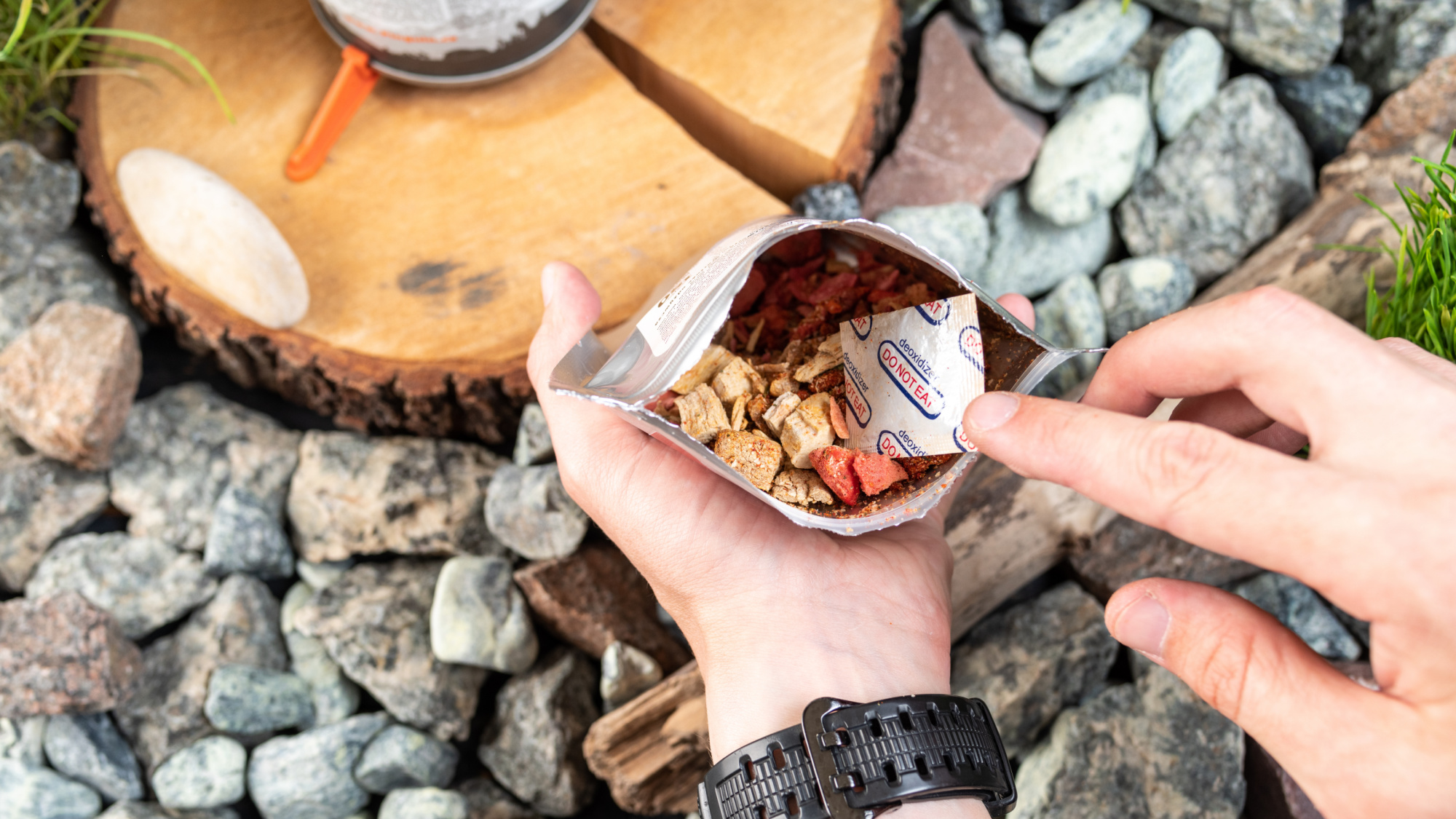
Luckily, the list of equipment required for dehydrating food and rehydrating it in the backcountry is pretty short. You’ll need:
- A food dehydrator
- A vacuum sealer and vacuum seal bags (if you’re using the food within the next few days or weeks, freezer bags or sandwich bags will suffice)
- Food-grade oxygen absorbers
- A backpacking stove and fuel
- A small pot (if not already integrated into the stove) and water
- A pot cozy (we’ll get to this in a minute)
- Camping utensils
Dehydrating Food: A Simple Step-by-Step Guide
McAllister discovered his affinity for dehydrating his own backpacking meals while preparing for a 30-day trip on the Appalachian Trail over a decade ago. Now he’s an expert on all things dehydrated, including foods, meals, and equipment. He has also published multiple books with recipes for chili, mac ‘n cheese, risotto, pasta, noodles, stew, and other hearty dishes.
There are two primary approaches to dehydrated backpacking meals, McAllister says. One is to cook the meal in its entirety and then dehydrate the whole thing before packaging it. The other is to dehydrate the ingredients (most of which need to be cooked individually) and assemble the meal in the backcountry. The method you choose should depend on what you’re cooking and how much work you want to do in the kitchen versus in the woods. For some actual backpacking meal recipes, jump here:
How to Dehydrate a Pre-Assembled Meal: Chili
- Cook your chili or other dish. Avoid adding any dairy products like cheese or sour cream for now. If you’re using meat, make sure it’s as lean as possible. (We’ll get to why fat is bad for dehydrating in a minute.) Try to avoid letting the chili get too soupy by cooking off any excess liquid.
- Let the chili cool completely. Spread it out on a wide, flat surface like a cookie sheet or a roasting pan and set it in the refrigerator. This might take a whole night.
- Dehydrate your chili. Follow your dehydrator-specific instructions, but make sure you spread an even layer and dehydrate it for long enough. It could take 12 hours or even longer, depending on your ingredients.
- Once the chili is fully dehydrated, seal it in an airtight bag with an oxygen absorber, label and date it, and store it until you’re ready to use it.
- When you’re ready to cook it, bring water to a boil. McAllister recommends 1.5 cups of water for every cup of dehydrated food. Add the chili. Rehydrate until all ingredients are soft again, roughly 15 minutes. Enjoy!
How to Dehydrate Individual Ingredients: Chicken Noodle Soup
- Cook your chicken, carrots, celery, onion, and noodles individually. Season them to your liking. Cooking these ingredients individually means you can get each of them to the perfect level of doneness rather than having al dente noodles and mushy veggies. (A tip from McAllister: slightly undercook any pasta or noodles before dehydrating them. Then, rinse them with cold water as soon as you strain them. This will both ensure they stop cooking at the right time and keep them from sticking together on the dehydrator tray.)
- Cool all your ingredients. If you haven’t already, shred or cut up the cooked chicken into small pieces.
- Dehydrate your ingredients. Again, follow your dehydrator-specific instructions here, but make sure every ingredient is fully dehydrated. This might mean dehydrating different ingredients, like chicken, on their own.
- Mix the dehydrated ingredients together and vacuum seal them in an airtight bag with an oxygen absorber. Label and date the meal.
- When rehydrating, bring water to a boil (using the 1.5 cups of water to 1 cup of food ratio) and add ingredients. Rehydrate fully and enjoy.
Dehydrating Meat
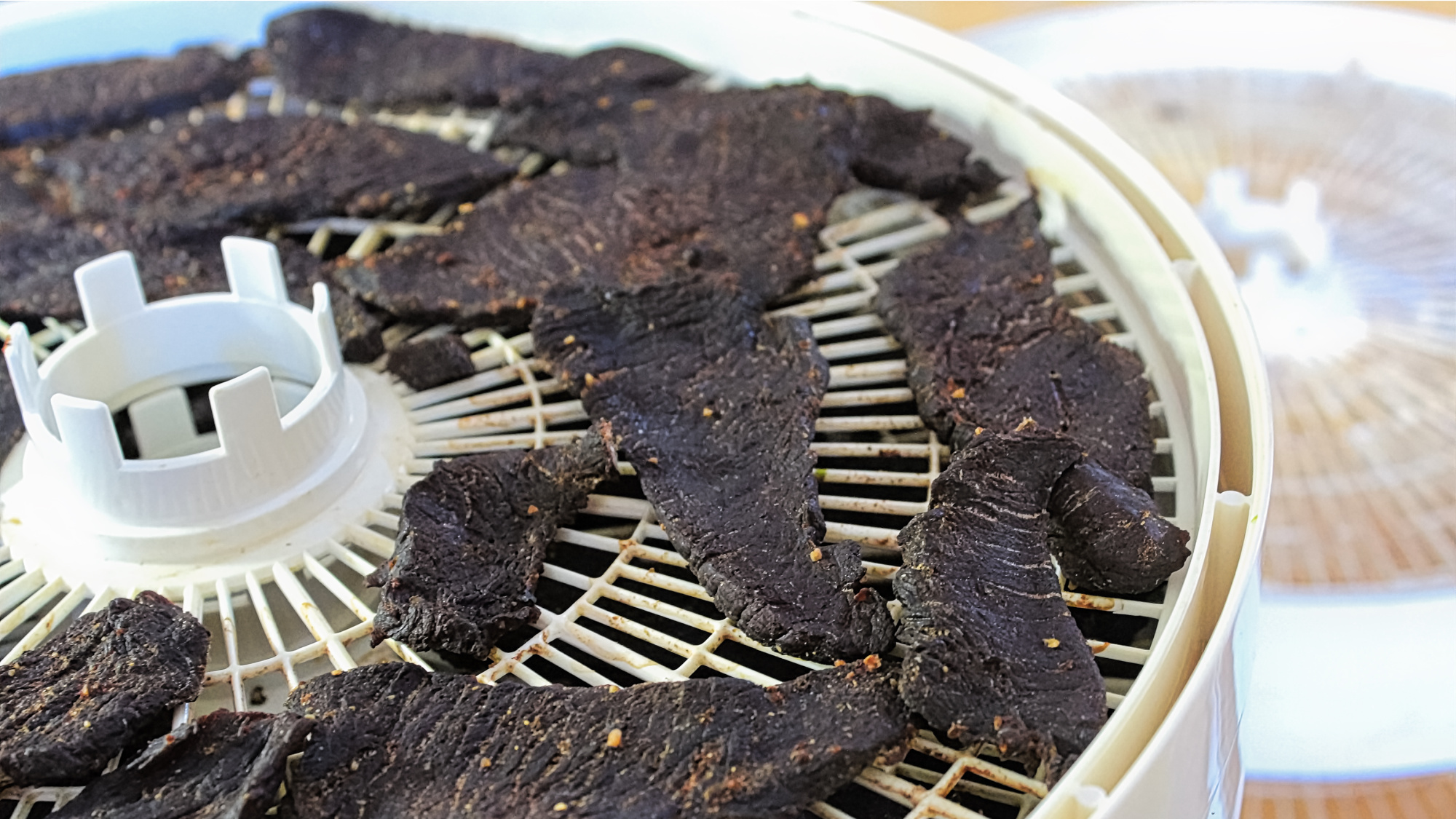
There are a few rules about dehydrating meat to keep in mind, McAllister says. These apply to any meat you might dehydrate, from ground beef or venison to poultry.
First of all, fat does not dehydrate. As a result, if large quantities of fat remain in a dehydrated meal, they will likely spoil within a few weeks. The absence of liquid and oxygen is what protects dehydrated food from spoiling, since both substances are breeding grounds for bacteria. If a package of dehydrated ground beef contains pockets of fat, the safety of that package is compromised.
To avoid this issue, McAllister recommends buying the leanest meat you can find, trimming fat, or drying meat of any oily residue after cooking it. Luckily for hunters, game meat (without any added fat) is spectacular for this purpose and will yield a protein-rich, fat-free grind that’s ripe for dehydrating.
Another important consideration for dehydrating meat is to ensure it’s fully cooked. This is especially important to keep in mind when cooking chicken. Make sure it reaches the proper internal temperature of 165 degrees Fahrenheit before cooling and dehydrating. This will eviscerate potentially harmful bacteria like salmonella and E. coli.
Lastly, the smaller the pieces of meat are, the quicker they will dehydrate. Make sure your ground meat is extra crumbly when you spread it on the dehydrator tray. Cube your chicken or shred it into small, stringy pieces. It may not seem that appetizing now, but when it takes less time to both dehydrate and rehydrate, your growling stomach will thank you.
Foods You Shouldn’t Dehydrate
Considering the cardinal rule of not dehydrating fat, a few foods are definitely off-limits for your dehydrator. They include:
- Raw meat (unless you’re making deer jerky)
- Cheese
- Milk or cream
- Butter
- Avocado
- Raw eggs (unless your dehydrator can reach 165 degrees F, which will kill salmonella)
If you simply can’t live in a world where pasta gets eaten without parmesan or potatoes aren’t accompanied by ketchup, just throw a few condiment packets or a small shaker of shelf-stable parmesan cheese in your cook kit. You can do the same with powdered milk or powdered coffee creamer. It’s also a good idea to stash a little bottle of cooking oil in your kit.
Cooking with Dehydrated Food
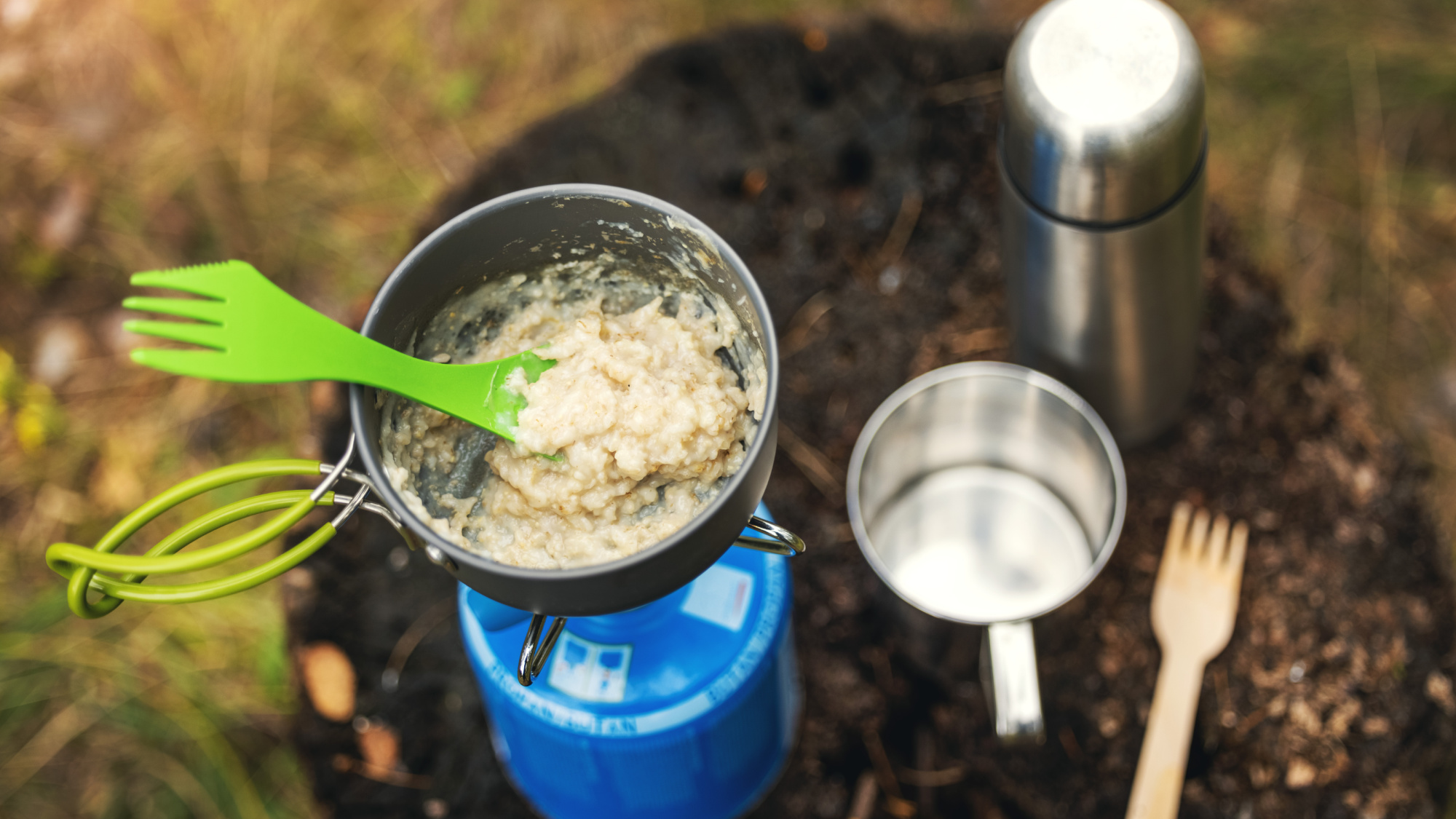
Once you’ve dehydrated your backpacking meals and set out on your trip, most of the hard work is done. Now, it’s dinnertime and you need to take your chili from its dry and flaky dehydrated state to a rich, hot, rehydrated meal. Here’s how.
Rehydrating Food
While the dehydrating process involves using heat and air to remove the water content of your food, rehydrating involves adding heated water back into the food. The joy of backpacking meals is their ease of preparation, especially when you have a reliable backpacking stove or some smoldering coals to heat water over.
McAllister recommends using 1.25 to 1.5 cups of water for every cup of dried food. Starchier foods like pasta, rice, and potato-based dishes will require more water to rehydrate, while a fruit salad blend or meat and vegetables won’t require quite as much. He encourages backcountry chefs to not be afraid to eyeball the water content, too.
Once the water is heated, add the meal, cover, and let it sit. You should have some sort of insulated pot “cozy,” as McAllister calls it. This easy-to-DIY tool, essentially a puffy jacket for your pot, serves a dual purpose. It both helps to retain the heat inside the pot for better rehydrating and it protects your hands while handling the outside of the pot. (Learn how to make a pot cozy on McAllister’s website here.)
Most importantly, while it is totally possible to get meticulous with your wilderness cooking skills, don’t be surprised if not every meal is rehydrated to the most perfect consistency. The point of bringing dehydrated meals into the woods is to have a hot, nutritious meal that can sustain you for long periods of time, not to have a dining experience worthy of a 5-star Yelp review. If you can look past ground meat that’s a little chewy or pasta sauce that’s a little too thin, all the better.
Storing Dehydrated Food
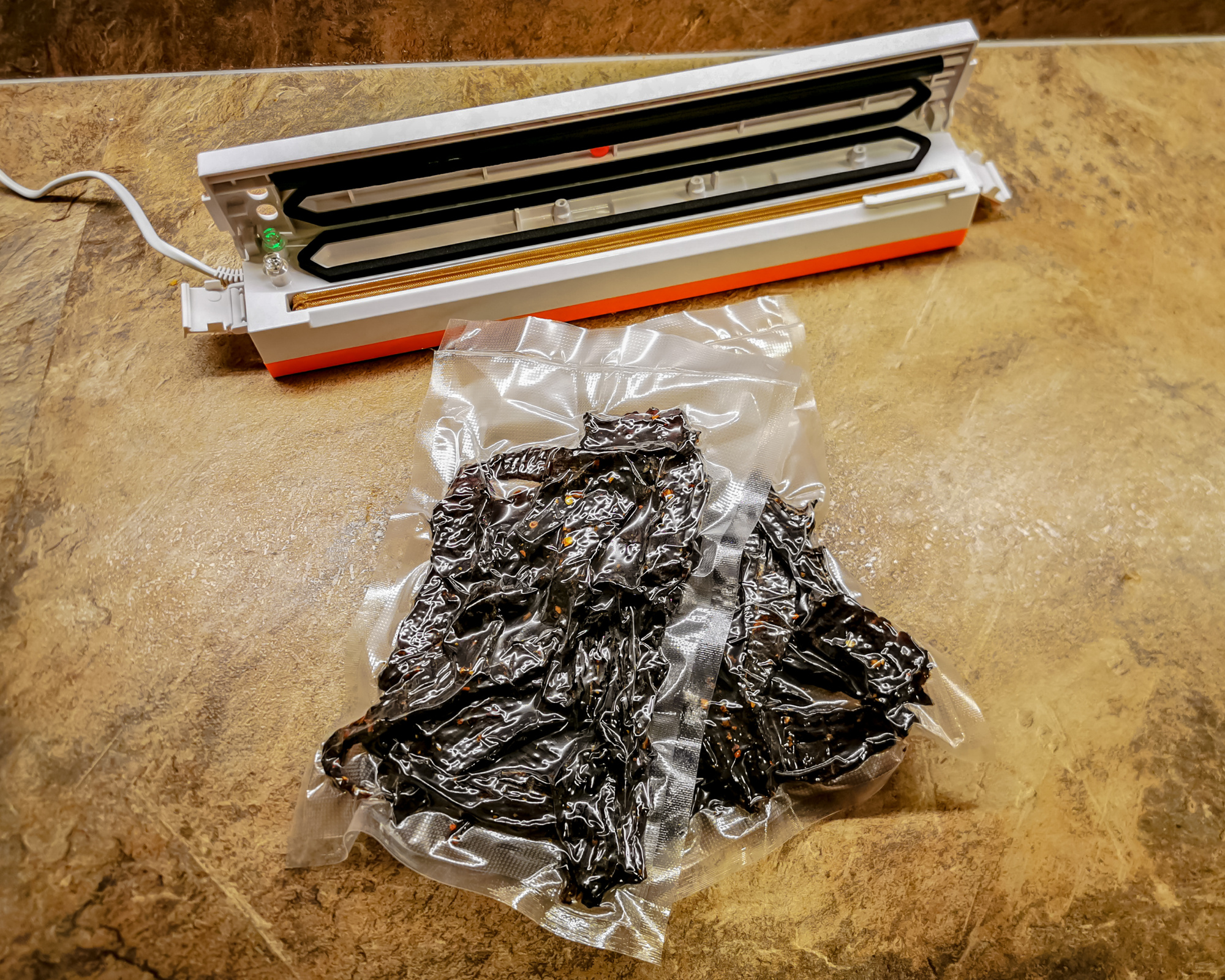
Dehydrated backpacking meals are best stored in airtight, vacuum-sealed plastic bags with a small oxygen absorber and stashed in a dark, temperature-controlled pantry. If you store the food properly, it can last without any deterioration for about a year, McAllister says.
“After a year, I have noticed a bit of a decline,” he says. “The process is oxidation, and that affects different foods in different ways. With fats, oxidation will cause the food to go rancid. Vegetables, even when stored properly, will change.”
McAllister blames this change in food quality over a long period of time on enzymes that remain active in raw fruits and vegetables.
“A good example is carrots,” he says. “If you were to dry raw carrots that you cut up into pieces, they’re probably going to get pale the longer they’re in storage. But if you steam them before you dehydrate them, they will maintain a much darker orange color. So I generally pre-cook vegetables before I dry and store them.”
He points out that some dehydrating enthusiasts will store their foods for longer, but he tries to cycle through his meals regularly. Oftentimes, his wife will take dehydrated meals to work in a Thermos or they’ll carry meals on day hikes, bike rides, and long drives.
“You’ll have a lot of different opinions about how long you can store food. Because I have a website that gets a lot of visitors, I feel responsible to give best practices,” McAllister says. “Try to use it up within a year. And there are plenty of ways to use it up. Just throw it in soup at home.”
What to Look For in a Food Dehydrator
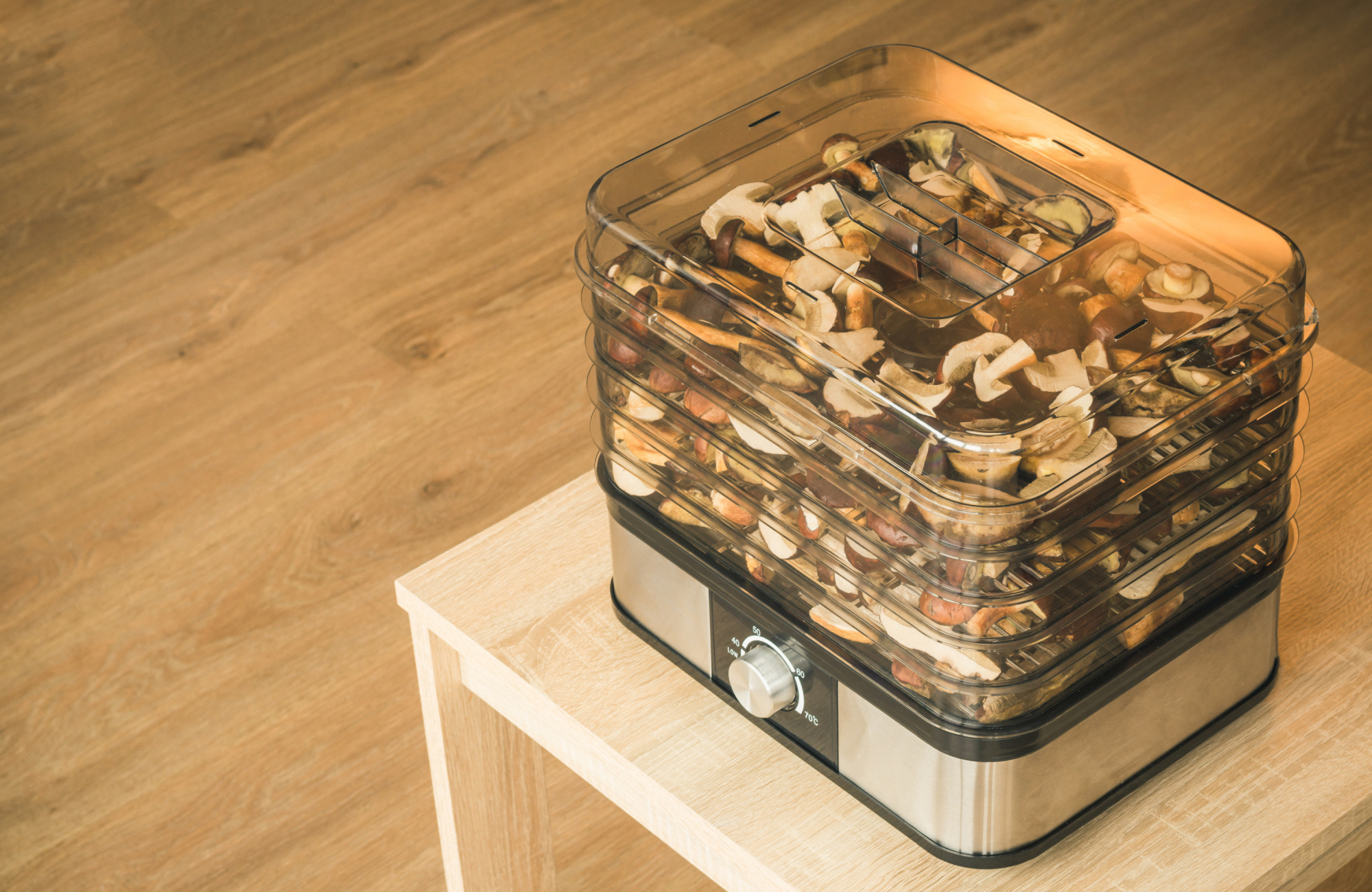
When it comes to shopping for food dehydrators, McAllister says the options are all over the place in terms of price point, capacity, and value. The good news is that you can probably find something that fits your budget and needs. The bad news is that the volume of choices can make shopping complicated.
“You can spend a lot of money on a good dehydrator, like the Excalibur 9-tray. Or you can get a mid-level capacity dehydrator, a newer brand is Casori, and that’s a very efficient machine,” McAllister says. “You can spend a small amount of money, maybe $150, and have a really good dehydrator, or you can spend $400 for an even better one. You can even spend $99 if you just wanted to test dehydrating out and get started.”
When the OL Gear Team tested the best dehydrators for jerky, they looked at options that ranged from five trays to 10 trays and $63 to $280 (currently on sale for $210). Consider your budget, your kitchen space, and your demand for dehydrated foods when purchasing a dehydrator. If you’re just making dehydrated meals for yourself and have a small kitchen, there’s no need to buy an expensive 10-tray dehydrator.
Dehydrated Backpacking Meal Recipes
With McAllister’s permission, we’re publishing a few of his recipes here. You can find more in his books, Recipes for Adventure: Healthy, Hearty and Homemade Backpacking Recipes and Recipes for Adventure II: The Best of Trail Bytes.
Thai Green Curry
Ingredients:
Green Curry Paste
- ¾ cup Thai Kitchen Curry Paste
- ½ tsp fresh grated ginger
- ½ tsp fish sauce
Thai Curry
- ½ cup precooked & dried Jasmine rice
- ¼ cup dried ground chicken
- ¼ cup dried mixed vegetables: red and orange bell peppers, carrots, onion, and green beans
- ¼ cup dried green curry paste
- 3 tbsp. Native Forest Coconut Milk Powder, packed in a separate bag
- 2 cups water to rehydrate
Steps:
- Spread ¾ cup Thai Kitchen Curry Paste mixed with fresh grated ginger and fish sauce thinly on dehydrator tray using nonstick sheet.
- Dehydrate at 135°F (57°C) until crumbly, about 6–7 hours. There is no need to grind the dried curry paste into powder—hand-crumbled is fine.
- Cook and dehydrate all other ingredients.
- Once on the trail, combine all ingredients with water in a pot.
- Soak the meal for 5 minutes before bringing the meal to a boil.
- Transfer the pot from the stove to an insulating cozy. Wait 15 minutes before eating.
Tomato Sauce Leather
Ingredients:
- 6 14.5-ounce cans diced tomatoes
- 1 tbsp garlic powder
- 2 tsp salt
- 2 tsp sugar
- 1 tsp onion powder
- ½ tsp pepper
- 1 tsp red pepper flakes
- 1½ tbsp dried basil
- 2 tsp dried oregano
- 2 tsp dried parsley
- 4 bay leaves
- 2 tbsp red wine vinegar
Steps:
- Run canned diced tomatoes through a blender to a smoothie-like consistency.
- Transfer sauce to a stock pot and add all seasonings.
- Bring sauce to a light boil over medium high heat, then reduce heat to low. Simmer uncovered for 60 to 90 minutes. Sauce will thicken as liquid evaporates. Once the sauce is thick, allow it to cool.
- Dehydrate the sauce into leather. This recipe yields 5 to 6 cups of thick sauce, which can be dried on five Excalibur dehydrator trays. Remove bay leaves. Spread 1 to 1.25 cups of tomato sauce thinly on each dehydrator tray covered with a non-stick sheet. Spreading too much sauce on a tray will make a thick leather that will take longer to dry and won’t reduce to tomato powder as well.
- Dehydrate at 135° F (57° C) for approximately 10 hours. After about six hours, tomato leather should be dry enough to remove the non-stick sheets. Flip non-stick sheets over onto mesh sheets and peel non-stick sheets away from leather. Finish drying on mesh sheets. When completely dry, you should be able to easily snap or tear it into smaller pieces.
- Blend tomato leather into tomato powder. Tear leather into smaller pieces and reduce to tomato powder in a blender. Work with small quantities so as not to overheat your blender.
- To reconstitute the tomato powder, combine ¼ cup tomato powder with 1¼ cups of water. Bring the mixture to a light boil and then remove the pot from heat. Wait 15 minutes or longer. The sauce thickens with time. Add more water, a tablespoon at a time, for a thinner sauce. Stir in a spoonful of extra virgin olive oil if desired. This is enough sauce for two or three servings of pasta.
This recipe yields approximately 24 tablespoons of tomato powder, enough for 10 to 12 backpacking meals that call for sauce. One quarter of a cup of leather will equal 2 tablespoons of powder.
Macaroni with Beef & Vegetables Recipe
Ingredients:
- ½ cup precooked & dried macaroni
- ¼ cup dried ground beef
- ¼ cup dried vegetables (Try a mix of dried bell peppers and dried olives)
- 2 tbsp tomato powder
- 1½ cups water to rehydrate
- Optional: A packet of parmesan cheese for a topping.
Steps:
- Combine all ingredients with water in pot and soak for 5 minutes.
- Light stove, bring to a boil, and continue cooking with the lid on for 1 minute.
- Place pot in an insulating pot cozy and wait 10-15 minutes.
- Top with parmesan cheese and extra virgin olive oil when serving, if desired.
Dehydrating Food FAQ
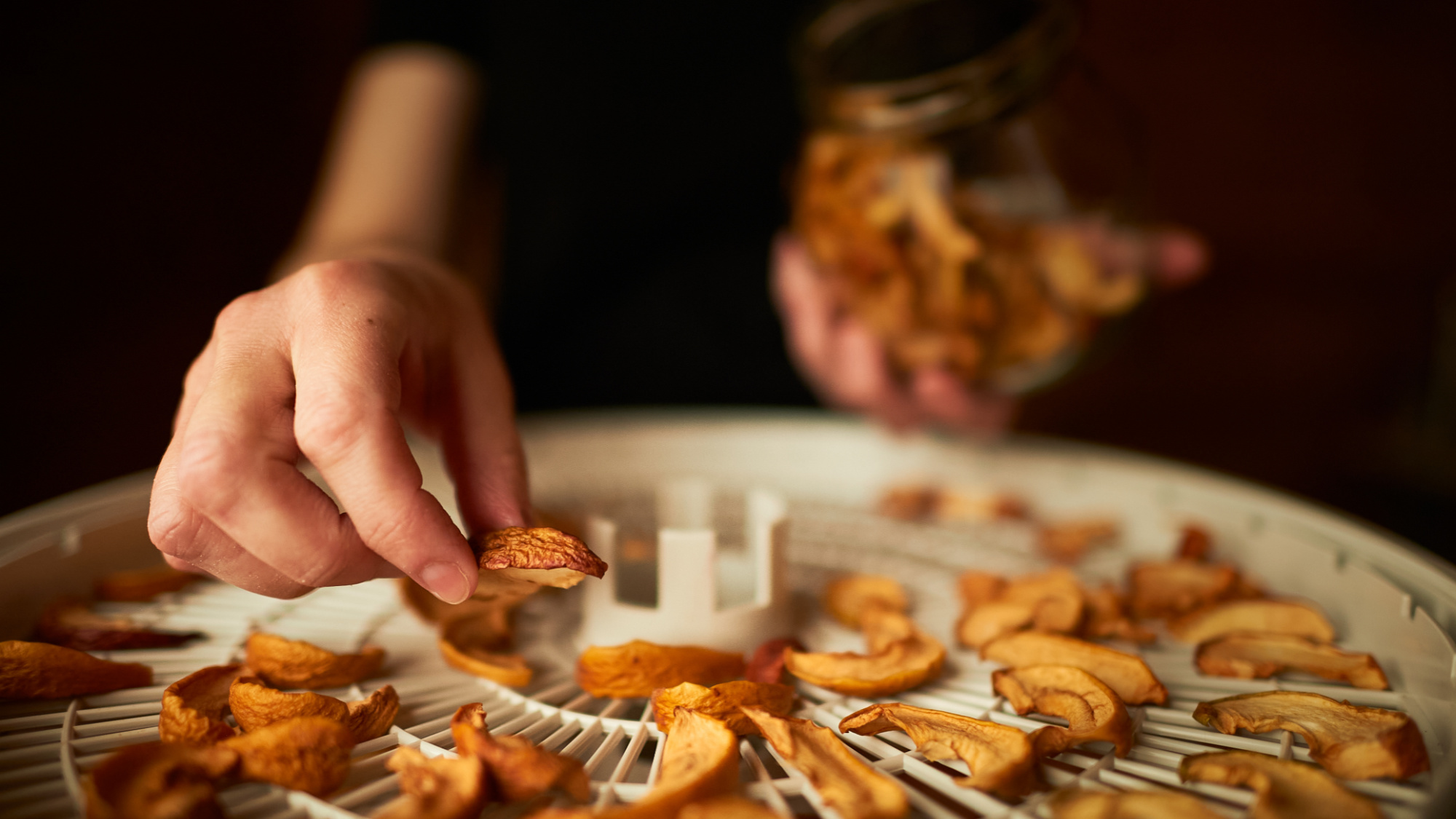
Lots of foods are primed for dehydrating. Cooked ground or shredded meat, cooked vegetables, fruits, pastas, rice, potatoes, stews, chili, and macaroni dishes are all great options for DIY backpacking meals. As long as you don’t try to dehydrate dairy, raw meat, raw eggs, or anything with a high fat content, you’ll be both satisfied and safe from illness.
Luckily, dehydrating food doesn’t really change the nutritional content of food. Unlike frying or curing, it doesn’t add any sodium or fat content to the meal aside from whatever seasoning you use. While it might reduce the amounts of Vitamins A, B, and C available in key ingredients, it can also increase the fiber content of food. Most nutritional content of dehydrated food remains the same.
If the ingredients of the meal were all prepared properly beforehand, then technically, yes, you can eat food without rehydrating it. In fact, lots of dehydrated fruits and vegetables make for good trail snacks. But when it comes to pre-assembled meals like chili, there’s going to be very little satisfying value to a brittle, crunchy bag of ground meat crumbles, dried beans, and other vegetables.
Final Thoughts on Dehydrating Food and Backpacking Meals
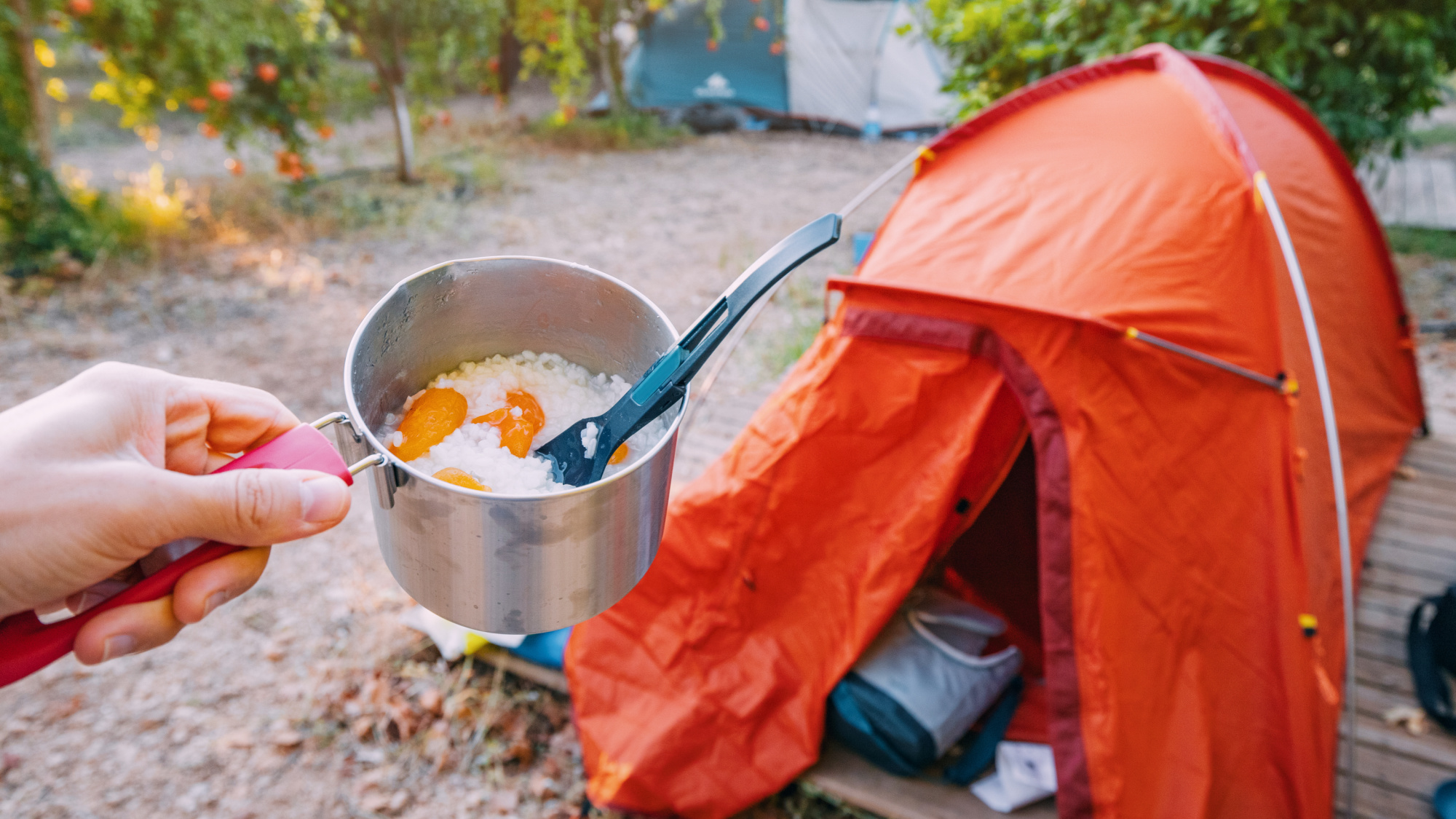
Dehydrated and freeze-dried meals have come a long way from Vietnam War-era MREs and Lipton soup packets. But now, outdoorsmen and women are becoming increasingly interested in creating their own backpacking meals to haul into the backcountry. As they should, McAllister says.
“Once you get into this, it’s really a lot of fun.”

